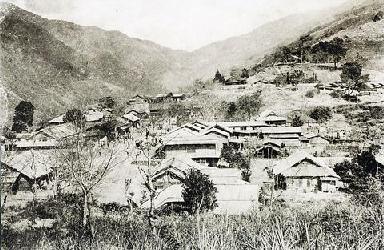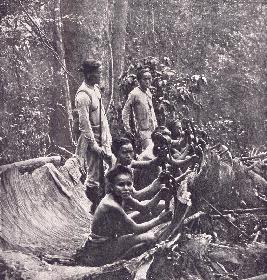|
|||||||||
|
This old photograph of Wushe taken a few years after 1930 seems to show an idyllic picture of tranquil mountain life for a people untroubled by the modern world.
However the reality for those conscious of history and the world beyond this seemingly tranquil spot would have been very different. |
|
||||||||
|
Photo : Deng Shiang-yang |
|||||||||
|
The Atayal were one of the earliest ethnic groups to inhabit the island of Taiwan, most probably coming from today's Philippine Islands. The Atayal were adept at living in the forested mountains which they believed to be the land of their ancestral spirits. The lowlands of the island were populated by a people known as the Pepo'hoan or 'lowland savages' to the Hoklo settlers. Amongst the Chi'hoan, or 'mountain savages', the north central Atayal tribe was considered both the proudest and the most fearsome : they were also the most numerous.
From the end of the 18th century Hoklo settlers from Fujian Province in China began arriving on the shores of Taiwan in greater numbers. The vast majority of these settlers were men, as prior to 1872 the Chinese Emperor had forbidden any female to leave the Celestial Empire. A process of natural assimilation thus began so that few traces of the Pepo'hoan are apparent. However the Atayal resisted all attempts of assimilation and remained untrusting of the Hoklo and Hakka settlers. |
|||||||||
|
The growth of the camphor trade in particular inflamed the situation. This highly lucrative business necessitated workers penetrating up to the middle reaches of the mountain forest to fell the huge and stately camphor trees. This was dangerous enough from the hazards of bears and snakes, but the workers were then obliged to spent several weeks first reducing the timber into small chips and then distilling the chips to extract the valuable camphor oil.
[The photograph on the left is from the National Geographic Magazine of March 1920, in an article entitled ' Formosa the Beautiful, by Kirjassoff]
Camphor became the area of interaction between the Chi'hoan and the Hoklo and Hakka. The Chi'hoan became aghast at the ravages being wrought to their lands which disregarded all respect for the spirits and integrity of the area. The Chi'hoan sought vengeance for their ancestors' spirits : the Hoklo and Hakka sought to satisfy the foreigners' demand for camphor oil. |
|||||||||
|
In many districts camphor workers require the protection of armed guards (Click on image to enlarge)
|
|||||||||
|
In 1895 the Ching Emperor gave Taiwan, an island to which he had only a tentative claim for less than half the land mass, to Japan in order to save his north east territories, the Manchu homeland.
The well-disciplined Japanese troops arrived in the north of Taiwan on 29 May 1895 to be met by disaffected Ching loyalists, disenchanted warlords and the self-proclaimed troops of the Republic of Taiwan. By the end of October 1895 the Hoklo and Hakka districts had been subjugated by the Japanese. The larger half of the Ilha Formosa, the mountain or 'kao' area, remained 'untamed' under the sway of the Chi'hoan or 'First Nations'. |
|||||||||
|
|||||||||

